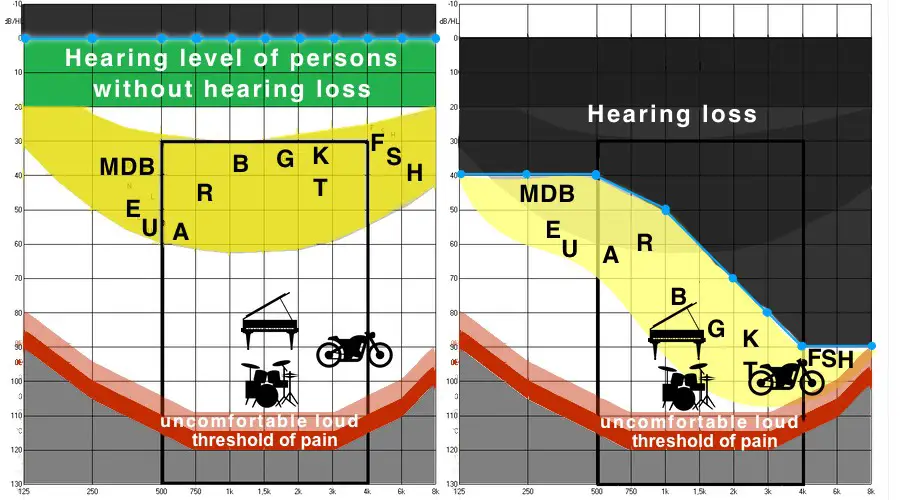Hearing aids can do so much in advertising and are too often so limited in their ability to compensate for hearing loss. I am writing this article based on my experience as a hearing care professional.
It is not that everything is bad about hearing aids for every hearing aid user. But some people just have such a bad experience with hearing aids that you have to say hearing aids suck.
The experience starts in the store with the high prices and ends at a birthday party with lots of people talking. The speech understanding is here, however, despite expensive devices far too often not satisfactory for the hearing aid user available.
Here it will be more concrete why I would like to express my frustration here. Limiting factors in the hearing aid fitting are:
- The hearing loss
- Limited perceptible frequency spectrum (limited by the speaker and the hearing impaired person)
- The lack of ability to correctly process what is heard again.
- Small auditory canals
- Inability to use additional devices in combination with the hearing aids
- Changed perception of their own voice (occlusion effect)

When Hearing Aids Suck and Still Are Being Used
A new customer came in spontaneously the other day who was very dissatisfied with his hearing aids. He was visibly annoyed and cursed relatively much about the hearing aids. However, he still had hope, because he asked me if I could do something for him.
Of course, I’m always happy about new customers and said whether I can do something we will see only when I have measured the hearing aids once and have looked at everything. Then I can describe my approach to him. He agreed and a short time later we sat together in the room for the measurement.
He first described his frustration:
- Everyone sounds so bad
- When I close the door on the car, it’s an explosion.
- I was in an important conversation the other day and didn’t understand anything
- My ears itch with the hearing aids
Ok, full of confidence and motivation I continued my documentation and finished my measurements. The result afterwards was quite sobering for the client. He still had 20% speech understanding in a quiet environment. (In a normalized speech test conducted in normal conversational volume).
There are wonderful measurement options where the professional can directly see which frequencies need more or less amplification from the hearing aid. Here, in particular, I prefer to use loudness scaling. Here I saw that the high frequencies simply needed much more volume.
The gentleman had a very small speaker that was not powerful enough. In addition, a custom earpiece with a large hole was used. However, with RIC (receiver in the canal) devices, the speakers can be replaced very quickly.
No sooner said than done. The new receiver with significantly more power was mounted. Here I had to use a closed silicone dome, because the new speaker in the setting in combination with a larger hole would lead to massive feedback. I did another fine tuning and saw that even the large speaker was not quite sufficient at those high frequencies. It worked much better but not perfectly. It never satisfies me when things are not woring perfectly.
We go again to the speech test. Let’s see what comes out now. We started with 20% in the old setting. Now we had 70% speech understanding with the new setting and the new speakers. Ok that is of course a noticeable improvement. The customer smiled at me and said “Hey that’s grea…” but halfway through the sentence he suddenly stopped. His cheerfulness changed and he looked at me puzzled.

Then he asked: “why my own voice was so loud?” I had previously prepared him for the fact that without the hole in the earmold, his own voice would be perceptible to him in a significantly different way. His short and honest statement: “This sucks!”
At such a moment, of course, I stay calm and and listen if there might be a chance for him accepting the changed perception of his own voice. He told me that he can never accept his voice like that. Under no circumstances. But he wants to be able to hear the surroundings as he does now.
In such a case, we would have to stay with a closed earpiece to be able to bring the amplification optimally to the ear. However, the closed earpiece also ensures that the own voice sounds so bad. Depending on the anatomy of the ear, it is possible to make an earpiece that is closed and at the same time presents one’s own voice more naturally.
However, he had quite small ear canals and the larger speaker just fit in. I can’t mill off anything on the speaker directly to make the situation better. The problem is that his lower jaw transmits vibrations into the ear canal, which can normally be dissipated with an open earpiece. But that is not the issue if you want to bring the amplification correctly to the ear.
In such a case, changing the amplification in the software in the range of your own voice or switching on the “Occlusion Manager” will rarely be really good. The client has very little hearing loss in the low frequencies. This means that the ear is closed and the own voice does not sound as usual. Newer hearing aids can sometimes change this, but his “old” hearing aids were only three years old and a new investment is out of the question.
I wanted to distract the customer once again from his own voice and went outside with him. As soon as we stood outside, a convertible drove by with loud music.
He looked at me and said that it no longer had anything to do with a natural sound. He could not enjoy music like that. I agreed with him because I actually used frequency compression during the hearing aid adjustment. If the hearing loss is so severe that certain frequency ranges can no longer be perceived, it is possible to shift higher frequencies more into the audible range.
This means that, for example, 6000Hz-8000Hz is now more perceptible between 4-5.5kHz. High tones that were no longer properly perceived are now perceptible but lower from the soundscape. Listening to music like this is really no pleasure. I can set up another program for this that is set a bit wider and works without frequency compression. But this was not desired.
He could understand me well outside with the ambient noise. His impression was much better than before but when he started to speak he said directly that it was not possible with his own voice. He also wanted to know why he could only hear 70% and not 100%. I explained that the sensory cells within his inner ear were defective and therefore certain sounds were no longer perceptible. Even if I would give a lot of amplification to his ear.
For this, the hearing care professional can use the TEN test which quickly shows dead regions. This means that in certain areas of the hearing simply can no longer take place. No matter how much volume meets those areas of the cochlear.
The client then asked me to reverse the modification on the hearing aid. His voice returned to normal. The speech comprehension became significantly worse again. I always comply with my customers’ wishes, even if I can’t always understand them. Personally, I would have preferred a better speech understanding. The customer decided against it.
Interestingly, he now no longer said that his hearing was poor. He was now happy with the knowledge that it would be better but that he would have to put up with a change in his own voice that he could not accept. I was also able to show him where his hearing was simply too limited and where it was reaching its limits. This made him happy and he no longer had the feeling that the bad feeling was due to the hearing aid but to himself. It was his defective hearing.
I personally was very unhappy with the old setting of the hearing aid. I would have preferred to optimize the performance of the hearing aid for maximum understanding. Confronted with these limitations, I briefly thought hearing aids suck. But the customer was satisfied. He sent me a couple more family members and friends because I was able to respond to his questions and adressed his problems individually and showed him where the hearing aid and his hearing have their limits.
Hearing Aids Are Frustrating in Noisy Environments
During the use of modern hearing aids, algorithms constantly scan the sound environment. The hearing aids recognize speech-like patterns and then adjust themselves so that a certain area in front of, behind or next to you can be heard better. The problem is that even high end hearing aids have a hard time separating the noise from the important speech, and preferably only making it perceptible to the hearing aid user.
As soon as it gets louder and many people speak in confusion, most people understand significantly less. 20% loss in terms of speech understanding is often measurable. If the brain has difficulty processing the sounds, the loss in speech understanding could be even more significant.
Yet many buy hearing aids for exactly these situations. In a quiet room it works but absolutely necessary would be an improvement in the noise. And this is only possible to a limited extent. Even directional microphone technology quickly reaches its limits at a very social party.
Additional microphones are often used by younger people who have no problem with a little technology. But the majority of hearing aid users are relatively old. Of course, I also show old people how the microphone works in connection with the hearing aid in noise. But the vast majority of them wave me off. Too complicated. Too much effort and too expensive.
For a microphone that is connected to the hearing aid to ask 1000 $ is also steep. But this is the rule rather than the exception in the hearing aid industry. However, the sales volume here is too low to make the price more reasonable. A cheaper option would be to use third part accessories, but this is often not possible, because hearing aid manufacturers prevent communication with other devices.
In the next few years, more will happen as more over-the-counter hearing aids flood the market.
I don’t want to speak completely against hearing aids in general. I like to fit them and for many people hearing aids are life-changing. But we shouldn’t close our eyes to the limitations of hearing aids and all the hearing aids bought that didn’t work and are lying in a drawer. Here is a study with more information on that topic.
